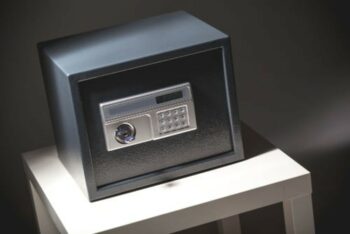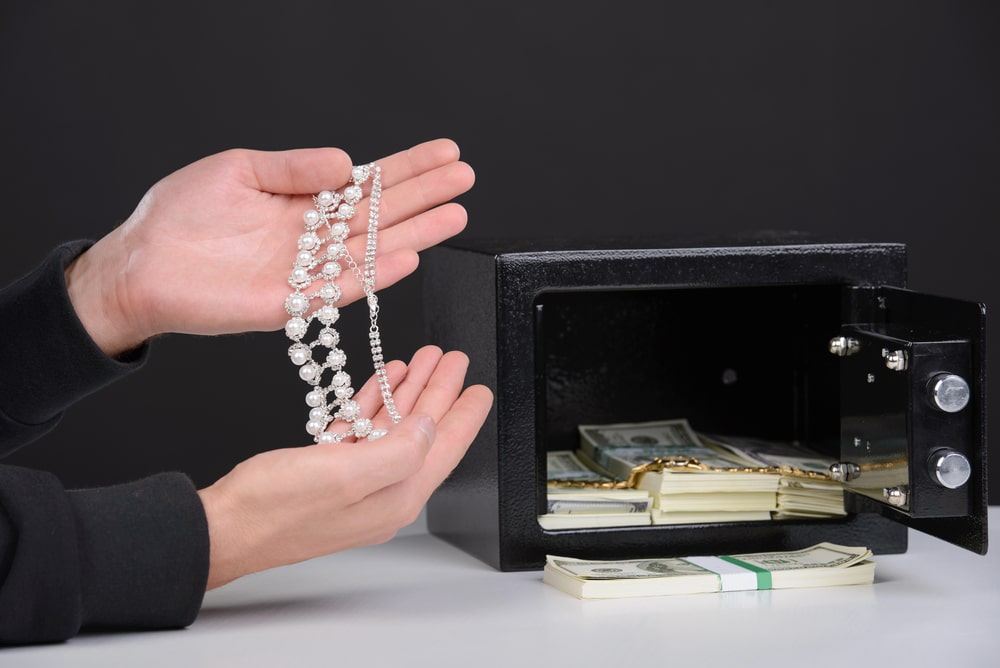Imagine coming home and returning to your most valuable items missing—including possessions that you can’t replace. Fortunately, safes provide you with peace of mind that thieves can’t access your important items in the event of a robbery.
But not all safes are created equal, and there are plenty to choose from: wall, burglar, fire and even laptop safes, as well as larger free standing safes, and more. In this article, we’re going to talk about what to look for in a home safe and some important factors to remember throughout your buying search.
What to Look for in a Home Safe
Check out our buying guide to help you discover what to look for in a home safe for high security at home or in a commercial setting. Choosing the right home safe for your security needs is a critical process, and there are important features to consider.
1. Size of the Safe
First, make a list of all the valuables you want to store inside the new safe to measure the cubic feet that you require. This might contain keys, important documents, cash, a laptop, and more. Bear in mind that home safes are great for storing a variety of items, so you can place numerous valuable items inside.

However, you don’t want the home safe to be too small for your valuables, so it’s critical that you know exactly what you’ll be placing inside before beginning your buying search. Also, remember that you should only place important valuables inside and not just use it as a storage mechanism, otherwise, you’re wasting valuable room when you could just place items in a drawer.
Remember that bigger is not always better as you’ll need to find a place to store the home safe—with a popular place being in the master bedroom. The last thing you want is the home safe standing out like a sore thumb and attracting attention to someone.
Once you’ve allocated all of the contents you’ll place inside, consider that each valuable might need some additional protection to prevent the items from cramping together, such as valuable paper documents that shouldn’t be squashed up next to jewellery, etc. For example, shelves and drawers are a great way to keep items organised.
2. Weight
The safe’s weight is also an important factor to consider. If it’s too light, it’ll be easier for a thief to pick up the safe and take it with them. Alternatively, if it’s too heavy, you might find it difficult to transport up a flight of stairs, move around your home, or take it with you on the go.
For maximum safety and security, you might want to consider bolting your safe to the floor. In fact, many safes come with four holes drilled into them, allowing you to permanently drill it to your home.
3. Cash Rating
Many people use security safes to store cash and high-end belongings. A safe with a cash rating means that you’re insured for a specific amount inside of the home safe. Most home safes offer insurance that protects you from £1,000 and can increase to £150,000.
View this post on Instagram
Cash ratings are important because it tells you the level of security that it offers. For example, if your home insurance company covers only £500 of cash if you’re burgled, a security safe might offer coverage up to £2,000, which means that it has a cash rating of £2,000.
You’ll want to assess the value of your contents in the home safe first. Then, multiply this value by 10 for optimal coverage. You should also be aware that the home safe needs to be securely and properly fitted for maximum protection in the event that you file a claim. Bear in mind that an insurer will take other factors into consideration too, such as open windows, unlocked doors, or if a burglar alarm is installed.
Furthermore, home security safes come with a test certificate such as EN 14450 S1, EN 14450 S2, or EN 1143-1. A Eurograde safe uses a number rating system (0–13) to reflect the level of security and cash protection it offers. The higher the number, the more cash rating it offers.
4. Type of Safe
Next, you’ll want to look at the different types of home safes available. The most common types to consider are a key or digital lock.
Key
A key home safe has a traditional operation and is well-suited if you’d prefer one without a digital screen. Plus, it might give you peace of mind that it’ll always be more reliable than an electronic version.
On the other hand, it can be easy to lose a key, which can make this type of lock be off-putting for some people. In fact, safe keys tend to be small, which makes you more likely to lose them than a door key. On some rare occasions, a key can sometimes bend or snap inside of the lock, resulting in you having to call out a professional and paying an extravagant charge to pick or drill the lock.
Electric
Alternatively, an electric home safe is becoming the more popular option—especially for hotel safes. They don’t require a key and are safe to use and adjust the digital codes. As you have the ability to easily change the code, an electronic locking mechanism can perform to your safety needs in hospitality or public environment.
View this post on Instagram
On the other hand, safes with a combination lock can be steeper to purchase. And forgetting the code can be disastrous, so it’s definitely not the best type of safe to choose if you have a forgetful memory. In fact, an electronic lock can only be picked by security experts, so forgetting the access code can lead to a tedious process and is much more complex than losing your key somewhere.
Gun Safes
In addition, a gun safe offers a high-security level for keeping weapons out of reach of children and pets. Make sure to consider the size of the gun(s) you own to determine if you want it stored barrel up or barrel down.
Wall Safes or Floor Safes
A wall safe has a sleek design that you can incorporate into any living setup. They’re exactly what springs to mind when you think of a safe from an action movie. However, they can’t support much weight, making them unsuitable for heavier items, aside from paperwork and photographs. Plus, they provide a permanent fixture, which isn’t appropriate for rented properties or if you often change your mind.
Alternatively, a floor safe can hold more weight since its design isn’t balancing against a wall. These offer a less permanent fixture, which is great if you live in a rented property. And you can also move them around from room to room easily.
Biometric
Finally, there’s also the option of a biometric safe—with pros and cons of this type of safe. This type of home safe doesn’t require a key or code. Instead, it uses a fingerprint design to open the safe. Simply place your fingertip onto the scanner, and it’ll unlock the safe.
Furthermore, they’re the quickest type of home safe to operate, so you can access your valuables in minimal time. This can be highly beneficial if you’re used to using gun safes where there’s a little delay. These security safes might also be the safest ones to use because nobody can guess a lock or access a key to open the safe. This extra layer of security means that you don’t have to be as careful about accessing the safe.
View this post on Instagram
Alternatively, this might not be the right safe for you if you won’t always have access to power. And there can be occasions where it results in a false scan. On most occasions, this is due to a faulty system, or moisture or dirt on the fingers. And as we age, our fingerprints become less noticeable, which can make this type of home safe more difficult to use with ageing.
5. Fire Protection
Another factor to consider is if the home safe offers fire protection. You’ll want a home safe with fire resistance to protect your contents from permanent damage. Most fire safes offer protection past 350 degrees Celsius, so your valuables will stay safe. And most safes with a high fire rating can be exposed to high heats for a couple of hours.
6. Material Used
Many safes are made of a concrete floor or a metal box for maximum burglary protection. These materials can deter thieves and can’t be cut open with tools. Avoid thin materials that make it easier for thieves to open.
To Sum It Up
Protecting your valuables is always a good habit to have, and you don’t just have to own just one home safe for your belongings. Now you know what to look for in a home safe, if you’re unsure about the right type for you, why not purchase several to keep various items protected? Do you have any tips on buying a safe? Let us know some factors that are important to you in the comments.
Additional Resources:
Amy is a U.K.-based writer and editor with a penchant for helping consumers find the best home products for their needs, as well as providing easily digestible guides for living better at home. Her dedication to her work means she can usually be found elbow-deep in research or hunting down samples of the latest and greatest on behalf of her readers.
An avid DIYer herself, Amy’s passion lies in teaching others how they too can achieve their dream homes by tackling some of those pesky projects themselves! Whether it’s building furniture from scratch or turning an old dresser into a coffee table, Amy is always happy to share what she knows about making your house feel like home without spending a fortune.

